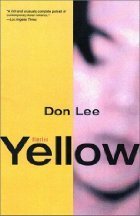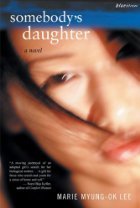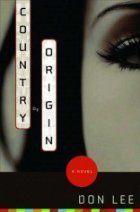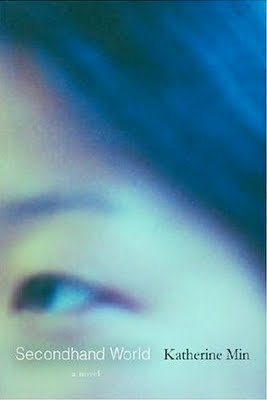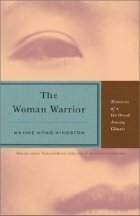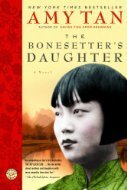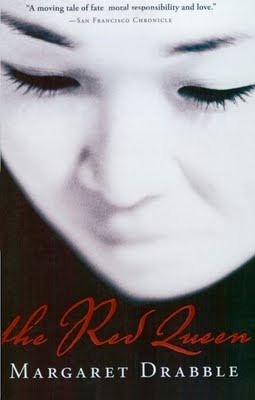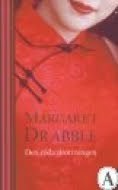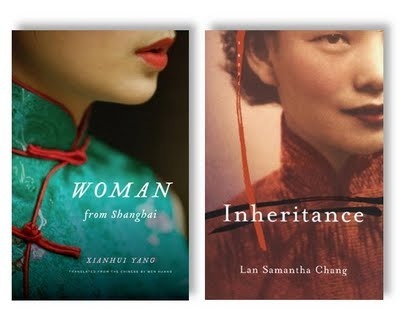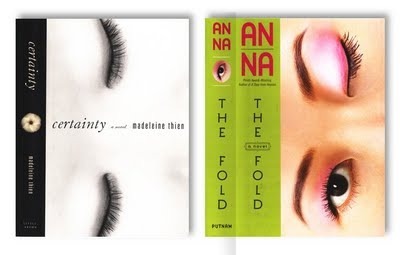Eugenia Kim's Blog, page 11
October 19, 2009
Kim traces courage in 'Calligrapher' Korean passage: Family's story set against Japanese incursion
By Geeta Sharma Jensen of the Journal Sentinel
Posted: Aug. 29, 2009
Eugenia Kim's sweeping debut, "The Calligrapher's Daughter," rises tall from a riveting scene that begs to be read and re-read - as does her entire novel about the painful change that Japanese occupation and modern ways bring to traditional, ritualistic Korea.
It is spring, 1924, Gaeseong in northern Korea. Calligrapher Han, an aristocratic scholar and artist, has arranged the marriage of his bright and headstrong 14-year-old daughter Najin, in keeping with traditional customs, but his wife, who was not consulted, opposes it.
"She's still a child and not yours alone!" the wife cries, arguing that Najin is educated, intelligent and deserves better. When Han refuses to soften, his wife secretly sends Najin off to serve in the court of the fading Yi monarchy.
Han, furious at his disobedient wife, loses his upper-crust decorum and hits her twice, drawing blood, then breaks down in tears. With that pivotal scene, Kim expertly sets the stage of the larger story: the crumbling of Han's centuries-old world; his wife, so traditionally polite that she refuses to show her teeth while eating, defies him to gain freedom and self-determination for a daughter; meantime, the Japanese are taking over ancestral properties and seeking to obliterate old-world Korean culture.
Through all the oppression, Najin (named after her mother's birthplace) triumphs, learning refined manners in court, getting a teaching degree, returning home to marry a pastor. Yet her happiness is not assured. The couple part, her husband sails for America, the Hans are forced to move to the big city after losing their wealth, and World War II comes to haunt Najin.
Kim, who has family in the Milwaukee area, says the novel was inspired by her own mother's life in Korea. Kim's prose is elegant, her eye compassionate, and her ability to effortlessly compress events over 30 years into a moving novel is admirable. But her greatest triumphs are her carefully calibrated and brave characters, who haunt you long after the novel is done.
Posted: Aug. 29, 2009
Eugenia Kim's sweeping debut, "The Calligrapher's Daughter," rises tall from a riveting scene that begs to be read and re-read - as does her entire novel about the painful change that Japanese occupation and modern ways bring to traditional, ritualistic Korea.
It is spring, 1924, Gaeseong in northern Korea. Calligrapher Han, an aristocratic scholar and artist, has arranged the marriage of his bright and headstrong 14-year-old daughter Najin, in keeping with traditional customs, but his wife, who was not consulted, opposes it.
"She's still a child and not yours alone!" the wife cries, arguing that Najin is educated, intelligent and deserves better. When Han refuses to soften, his wife secretly sends Najin off to serve in the court of the fading Yi monarchy.
Han, furious at his disobedient wife, loses his upper-crust decorum and hits her twice, drawing blood, then breaks down in tears. With that pivotal scene, Kim expertly sets the stage of the larger story: the crumbling of Han's centuries-old world; his wife, so traditionally polite that she refuses to show her teeth while eating, defies him to gain freedom and self-determination for a daughter; meantime, the Japanese are taking over ancestral properties and seeking to obliterate old-world Korean culture.
Through all the oppression, Najin (named after her mother's birthplace) triumphs, learning refined manners in court, getting a teaching degree, returning home to marry a pastor. Yet her happiness is not assured. The couple part, her husband sails for America, the Hans are forced to move to the big city after losing their wealth, and World War II comes to haunt Najin.
Kim, who has family in the Milwaukee area, says the novel was inspired by her own mother's life in Korea. Kim's prose is elegant, her eye compassionate, and her ability to effortlessly compress events over 30 years into a moving novel is admirable. But her greatest triumphs are her carefully calibrated and brave characters, who haunt you long after the novel is done.
Published on October 19, 2009 20:23
•
Tags:
calligrapher-s, daughter, journal-sentinal, milwaukee, review
A Woman of Consequence in a Time of War
By Sybil Steinberg
Special to The Washington Post
Wednesday, August 26, 2009
THE CALLIGRAPHER'S DAUGHTER
By Eugenia Kim
Henry Holt. 386 pp. $26
One bizarre image tends to dominate Americans' impressions of Korea: that of dictator Kim Jong Il, whose catastrophic reign overshadows centuries of a rich, complex culture.
Eugenia Kim's sensitive first novel, which depicts 30 years of Korea's modern history in light of its ancient past, is an illuminating prequel to present-day events. Set from 1915 to 1945, it's an intrinsically interesting account of the collisions of cultures: the strict traditions of the aristocratic (yangban) class gradually superseded by the inevitable changes of modernity and the attempted erasure of Korean language and traditions by the occupying Japanese. Against this dark background, Kim recounts a poignant family history, much of it based on her own mother's life.
Najin Han, the daughter of a brilliant classical "literati-scholar-artist" and calligrapher, is the protagonist and narrator of much of the story. Born in 1910 during the initial years of the Japanese annexation of her homeland, she is constricted by her stern, strictly conservative father's ideas about filial respect and the subjugation of women and also by the punitive laws imposed on the Korean people by their conquerors. When Najin's father decides to marry her off at age 14, her mother defies him by sending their spirited, intelligent and ambitious daughter to Seoul, where she becomes a companion to the young Princess Deokhye during the waning days of the centuries-old dynasty.
Later, a determined Najin attends Ewha Women's College in Seoul. At age 22, when the Japanese close the rural school where she is the principal, she finds, to her surprise, that she can love her parents' new choice of a husband. He is Calvin Cho, who is about to embark for America, where he'll study for the ministry. A vista of further education and intellectual independence opens to Najin.
Until this point, the narrative is keenly and often lyrically observed but somewhat slow to develop dramatic momentum. However, the sweep of fate that destroys Najin's hopes injects tragic intensity into the story. The day after her wedding, Najin is denied a passport. She spends the next decade separated from her husband, first in servitude to her lower-class in-laws, then in a penurious existence with her parents as the war in Asia flares and Japan robs Korea of its rice and its population.
Kim's account acquires depth and immediacy as she draws vivid pictures of wartime poverty and hardship. Throughout the narrative, she gradually reveals many facets of Korean identity, especially the role of religion, where devout Christianity exists in harmony with Confucian belief and ritual. As Najin begins to question Christian doctrine about the sanctity of suffering and sacrifice, her conflicting emotions add dimension to her character.
In quietly recording the arc of a woman's experience from idyllic childhood through harrowing adulthood, Kim mirrors the changing nation. The ending of the book is somewhat rushed, as Kim tries to encapsulate events in the immediate postwar period, but overall this is a satisfying excursion into empathetically rendered lives.
Steinberg was Forecasts editor of Publishers Weekly.
Special to The Washington Post
Wednesday, August 26, 2009
THE CALLIGRAPHER'S DAUGHTER
By Eugenia Kim
Henry Holt. 386 pp. $26
One bizarre image tends to dominate Americans' impressions of Korea: that of dictator Kim Jong Il, whose catastrophic reign overshadows centuries of a rich, complex culture.
Eugenia Kim's sensitive first novel, which depicts 30 years of Korea's modern history in light of its ancient past, is an illuminating prequel to present-day events. Set from 1915 to 1945, it's an intrinsically interesting account of the collisions of cultures: the strict traditions of the aristocratic (yangban) class gradually superseded by the inevitable changes of modernity and the attempted erasure of Korean language and traditions by the occupying Japanese. Against this dark background, Kim recounts a poignant family history, much of it based on her own mother's life.
Najin Han, the daughter of a brilliant classical "literati-scholar-artist" and calligrapher, is the protagonist and narrator of much of the story. Born in 1910 during the initial years of the Japanese annexation of her homeland, she is constricted by her stern, strictly conservative father's ideas about filial respect and the subjugation of women and also by the punitive laws imposed on the Korean people by their conquerors. When Najin's father decides to marry her off at age 14, her mother defies him by sending their spirited, intelligent and ambitious daughter to Seoul, where she becomes a companion to the young Princess Deokhye during the waning days of the centuries-old dynasty.
Later, a determined Najin attends Ewha Women's College in Seoul. At age 22, when the Japanese close the rural school where she is the principal, she finds, to her surprise, that she can love her parents' new choice of a husband. He is Calvin Cho, who is about to embark for America, where he'll study for the ministry. A vista of further education and intellectual independence opens to Najin.
Until this point, the narrative is keenly and often lyrically observed but somewhat slow to develop dramatic momentum. However, the sweep of fate that destroys Najin's hopes injects tragic intensity into the story. The day after her wedding, Najin is denied a passport. She spends the next decade separated from her husband, first in servitude to her lower-class in-laws, then in a penurious existence with her parents as the war in Asia flares and Japan robs Korea of its rice and its population.
Kim's account acquires depth and immediacy as she draws vivid pictures of wartime poverty and hardship. Throughout the narrative, she gradually reveals many facets of Korean identity, especially the role of religion, where devout Christianity exists in harmony with Confucian belief and ritual. As Najin begins to question Christian doctrine about the sanctity of suffering and sacrifice, her conflicting emotions add dimension to her character.
In quietly recording the arc of a woman's experience from idyllic childhood through harrowing adulthood, Kim mirrors the changing nation. The ending of the book is somewhat rushed, as Kim tries to encapsulate events in the immediate postwar period, but overall this is a satisfying excursion into empathetically rendered lives.
Steinberg was Forecasts editor of Publishers Weekly.
Published on October 19, 2009 20:21
•
Tags:
calligrapher-s, daughter, post, review, washington
The Calligrapher’s Daughter: A novel set during the 30-year oppression of Korea by the Japanese.
By Yvonne Zipp | August 21, 2009 edition
It might be the fashion today to name girls after cities: Brooklyns, Savannahs, and Parises show up in plenty of elementary classrooms. But in 1915 Korea, it was rather a different matter.
The protagonist of The Calligrapher’s Daughter was born the year Japan occupied Korea, and her father, a scholar whose art had won favor with the royal family, couldn’t bear to name her.
So for years, Eugenia Kim writes in this debut novel based on the life of her mother, she was known as “the daughter of the woman from Nah-jin.” That rather unwieldy title got shortened when a missionary, whose Korean was a little shaky, misunderstood and inadvertently christened her Najin. This wasn’t exactly an auspicious moniker, at least as far as her Confucian father Han was concerned. But then, his only daughter didn’t really please him at, well, anything.
In fact, while he knows it isn’t fair, Najin remains for him a symbol of his beloved country’s oppression and his own family’s decline. Fortunately, she spends most of her time with her mother, Haejung, a model of Christian serenity – at least until her beloved daughter’s welfare is at stake. She fights tenaciously for Najin to get an education, without ever once raising her voice or nagging.
For example, when Han decides to marry the 14-year-old Najin to the son of an old colleague, her mother and aunt go behind his back and wangle a court appointment for her in Seoul. While Najin does acquire polish serving the doomed royal family, there’s also a handy girls’ high school nearby.
Less easy to manage are the Japanese, who slowly strip away everything the aristocratic Hans have owned for the past 500 years. “The Calligrapher’s Daughter” takes a contemplative pace, as it chronicles the life of one family under 30 years of Japanese oppression. Kim doesn’t play down the privations or brutality of those years, nor does she indulge in graphic descriptions that would offend the exquisite manners of her characters. (The unspoken rules are so elaborate, I felt as if I needed an etiquette course to approach the book properly.) Sometimes, the result can seem a little distant, with a few chapters in the beginning sounding like someone reminiscing from a distance of decades. And exposition occasionally overtakes storytelling, although that becomes less noticeable as the book progresses.
But a girl balancing loyalty to her family with a desire to move beyond the narrow confines proscribed for her has struck a chord since Mulan (the original Chinese tale, not the Disney movie). Kim builds a patient spell, carefully orienting American readers who probably know little of this chapter of history. And with Najin having to face the Great Depression, World War II, and life under an occupying force – as well as a disapproving father – readers can hardly complain of boredom.
Fans of Lisa See’s or Amy Tan’s novels should eagerly embrace Najin, and “The Calligrapher’s Daughter” bids fair to become a staple of book clubs. While the story is Najin’s, its true subject is Korea’s occupation by Japan. “Only much later did I understand that the sweeping change of those years demanded the stringent practice of our rituals and traditions; to venerate their meaning, yes, but also to preserve their existence simply by practicing them,” Najin recounts.
Her mother teaches young Najin by scratching words with a needle onto stiff cloth, and then rubs the marks away. Han gives up his life’s work, because he refuses to pollute his art by selling it – especially to the Japanese.
Much the way that the English outlawed kilts and Gaelic in Scotland, upper-class Koreans aren’t allowed to wear white and children are taught in Japanese. Like something out of Orwell, Najin’s father is tortured by the Thought Police, and there are “clean-house inspections” that allow Japanese officials to enter people’s homes whenever they wish.
While Najin’s stern father and Bible-quoting mother seem rather clichéd on the surface, Kim manages to make them anything but cardboard. Calligrapher Han’s most difficult qualities are also what make him admirable: his Confucian ideals, moral certainty, and stubborn unwillingness to abandon Korea’s traditions. Haejung may seem utterly passive. But at the same time that she’s counseling obedience, she’s the force driving her daughter into the modern era and the steel core that keeps the Hans together under the worst conditions.
And Najin herself wins the sympathy of modern readers without feeling like an anachronism plunked down among historical wallpaper – a tricky balance for any writer. I found the novel’s ending abrupt, but realized afterward that that partly stemmed from my reluctance to let “The Calligrapher’s Daughter” go.
Yvonne Zipp regularly reviews fiction for the Monitor.
It might be the fashion today to name girls after cities: Brooklyns, Savannahs, and Parises show up in plenty of elementary classrooms. But in 1915 Korea, it was rather a different matter.
The protagonist of The Calligrapher’s Daughter was born the year Japan occupied Korea, and her father, a scholar whose art had won favor with the royal family, couldn’t bear to name her.
So for years, Eugenia Kim writes in this debut novel based on the life of her mother, she was known as “the daughter of the woman from Nah-jin.” That rather unwieldy title got shortened when a missionary, whose Korean was a little shaky, misunderstood and inadvertently christened her Najin. This wasn’t exactly an auspicious moniker, at least as far as her Confucian father Han was concerned. But then, his only daughter didn’t really please him at, well, anything.
In fact, while he knows it isn’t fair, Najin remains for him a symbol of his beloved country’s oppression and his own family’s decline. Fortunately, she spends most of her time with her mother, Haejung, a model of Christian serenity – at least until her beloved daughter’s welfare is at stake. She fights tenaciously for Najin to get an education, without ever once raising her voice or nagging.
For example, when Han decides to marry the 14-year-old Najin to the son of an old colleague, her mother and aunt go behind his back and wangle a court appointment for her in Seoul. While Najin does acquire polish serving the doomed royal family, there’s also a handy girls’ high school nearby.
Less easy to manage are the Japanese, who slowly strip away everything the aristocratic Hans have owned for the past 500 years. “The Calligrapher’s Daughter” takes a contemplative pace, as it chronicles the life of one family under 30 years of Japanese oppression. Kim doesn’t play down the privations or brutality of those years, nor does she indulge in graphic descriptions that would offend the exquisite manners of her characters. (The unspoken rules are so elaborate, I felt as if I needed an etiquette course to approach the book properly.) Sometimes, the result can seem a little distant, with a few chapters in the beginning sounding like someone reminiscing from a distance of decades. And exposition occasionally overtakes storytelling, although that becomes less noticeable as the book progresses.
But a girl balancing loyalty to her family with a desire to move beyond the narrow confines proscribed for her has struck a chord since Mulan (the original Chinese tale, not the Disney movie). Kim builds a patient spell, carefully orienting American readers who probably know little of this chapter of history. And with Najin having to face the Great Depression, World War II, and life under an occupying force – as well as a disapproving father – readers can hardly complain of boredom.
Fans of Lisa See’s or Amy Tan’s novels should eagerly embrace Najin, and “The Calligrapher’s Daughter” bids fair to become a staple of book clubs. While the story is Najin’s, its true subject is Korea’s occupation by Japan. “Only much later did I understand that the sweeping change of those years demanded the stringent practice of our rituals and traditions; to venerate their meaning, yes, but also to preserve their existence simply by practicing them,” Najin recounts.
Her mother teaches young Najin by scratching words with a needle onto stiff cloth, and then rubs the marks away. Han gives up his life’s work, because he refuses to pollute his art by selling it – especially to the Japanese.
Much the way that the English outlawed kilts and Gaelic in Scotland, upper-class Koreans aren’t allowed to wear white and children are taught in Japanese. Like something out of Orwell, Najin’s father is tortured by the Thought Police, and there are “clean-house inspections” that allow Japanese officials to enter people’s homes whenever they wish.
While Najin’s stern father and Bible-quoting mother seem rather clichéd on the surface, Kim manages to make them anything but cardboard. Calligrapher Han’s most difficult qualities are also what make him admirable: his Confucian ideals, moral certainty, and stubborn unwillingness to abandon Korea’s traditions. Haejung may seem utterly passive. But at the same time that she’s counseling obedience, she’s the force driving her daughter into the modern era and the steel core that keeps the Hans together under the worst conditions.
And Najin herself wins the sympathy of modern readers without feeling like an anachronism plunked down among historical wallpaper – a tricky balance for any writer. I found the novel’s ending abrupt, but realized afterward that that partly stemmed from my reluctance to let “The Calligrapher’s Daughter” go.
Yvonne Zipp regularly reviews fiction for the Monitor.
September 13, 2009
Jia, by Hyejin Kim
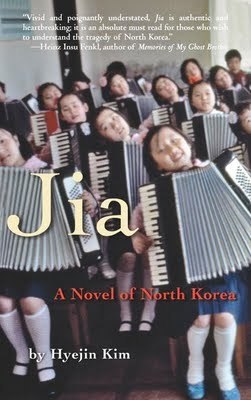
A novel that is based on the life of a young woman met by the author during a one-year stay in China doing humanitarian work near the North Korean border. Having just read two harrowing memoirs about coming of age in North Korea, it seemed awkward to be reading a novel about similar circumstances, but I think it was because the voice of the narrator felt startling in comparison to the other two books, both by men. Jia is the daughter of a dancer of high-class NK pedigree (by NK standards) and...
Published on September 13, 2009 13:22
September 11, 2009
This Is Paradise! My North Korean Childhood, by Hyok Kang
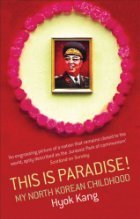
Because so little is written from eyewitnesses who have survived the famines of North Korea, this book has its place in informing and revealing the closely held secrets of the DPRK regime. Kang describes his youth and schooling, and the gradual descent of the country into hunger and deprivation, where the social structure, based on suspicion on idolatry, begin to show its weaknesses as neighbors and family members turn against each other to have another few cobs of maize. Children abandoned b...
Published on September 11, 2009 06:01
September 8, 2009
The Aquariums of PyongYang by Kang Chol-Hwan and Pierre Rigoulot

For ten years in his youth, Kang was a prisoner in Yodok, a North Korean concentration camp geared toward "reeducating" ideological traitors and their families. Kang's grandfather had been arrested and "disappeared" for treasonous acts against the Fatherhood, Kim Il-sung. What's likely is that the wealthy Korean-Japanese Kang clan had overstepped their boundaries; were fish out of water by being Korean Japanese, and though the grandmother was a rabid communist believer, the family managed to ...
Published on September 08, 2009 19:03
August 24, 2009
Asian American Book Covers, Clichéd
Published on August 24, 2009 20:25
June 16, 2009
Art of the Korean Renaissance: 1400-1600, by the Metropolitan Museum of Art

The lauded exhibition is concise with quality pieces that truly reflect the era. The pieces are integrated in this catalog with concise and brief, yet comprehensive histories of the kingships and mores of this period in approachable and at times compelling narratives by historians and art historians. An exceptional collection that is enhanced by this exceptional book.
Published on June 16, 2009 21:37
June 15, 2009
Publishers Weekly starred review
The Calligrapher's Daughter A Novel
★ The Calligrapher’s Daughter
Eugenia Kim. Holt, $26 (400p) ISBN 978-0-8050-8912-7
This debut novel, inspired by the life of the author’s Korean mother, is a beautiful, deliberate and satisfying story spanning 30 years of Korean history. The tradition-bound aristocratic calligrapher Han refuses to name his daughter because she is born just as the Japanese occupy Korea early in the 20th century. When Han finds a husband for Najin (nicknamed after her mother’s birthplace) at 14, her mother objects and instead sends her to the court of the doomed royal Yi family to learn refinement. Najin goes to college and becomes a teacher, proving herself not only as a scholar but as a patriot and humanitarian. She returns home to marry, but her new husband goes without her to study in America when she is denied a visa. As the Japanese systematically obliterate ancient Korean culture and the political climate worsens, so do Najin’s fortunes. Her family is reduced to poverty, their home is seized and Najin is imprisoned as a spy while WWII escalates. The author writes at a languorous pace, choosing not to sully her elegant pages with raw brutality, but the key to the story is Korea’s monumental suffering at the hands of the Japanese. (Aug.)
★ The Calligrapher’s Daughter
Eugenia Kim. Holt, $26 (400p) ISBN 978-0-8050-8912-7
This debut novel, inspired by the life of the author’s Korean mother, is a beautiful, deliberate and satisfying story spanning 30 years of Korean history. The tradition-bound aristocratic calligrapher Han refuses to name his daughter because she is born just as the Japanese occupy Korea early in the 20th century. When Han finds a husband for Najin (nicknamed after her mother’s birthplace) at 14, her mother objects and instead sends her to the court of the doomed royal Yi family to learn refinement. Najin goes to college and becomes a teacher, proving herself not only as a scholar but as a patriot and humanitarian. She returns home to marry, but her new husband goes without her to study in America when she is denied a visa. As the Japanese systematically obliterate ancient Korean culture and the political climate worsens, so do Najin’s fortunes. Her family is reduced to poverty, their home is seized and Najin is imprisoned as a spy while WWII escalates. The author writes at a languorous pace, choosing not to sully her elegant pages with raw brutality, but the key to the story is Korea’s monumental suffering at the hands of the Japanese. (Aug.)
Published on June 15, 2009 23:39
•
Tags:
publishers, pw, review, starred, weekly
May 24, 2009
Everlasting Empire, by Yi In-Hwa
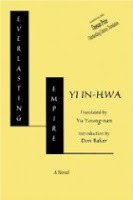
Translated by Yu Young-nan (2002 Daesan Prize for Outstanding Literary Translation), with an iIntroduction by Don Baker.
An historical fiction that examines the last years of King Chongjo (r. 1777-1800), the grandson of King Yongjo, and more notably, the son of Crown Prince Sado, who was killed by his father, King Yongjo, who asked him to step into a rice chest and sealed it, whereupon he died of starvation. For more on that compelling story, The Memoirs of Lady Hyegyeong (wife of Crown Princ...
Published on May 24, 2009 21:13

